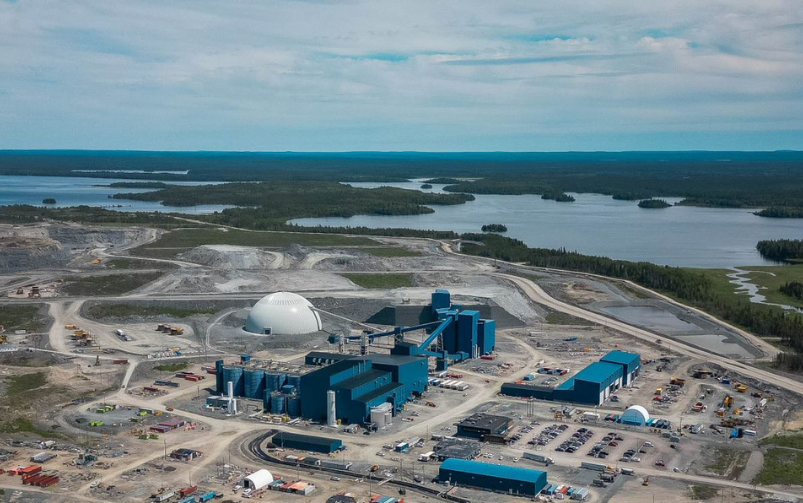Agnico Eagle’s Detour Lake, the largest gold producing mine in Canada, will be undergoing expansion to extend its mine life. Courtesy of Agnico Eagle.
Welcome back to your weekly mining news recap, where we catch you up on some of the news you may have missed. This week’s headlines include a high-profile appointment that may put the brakes on deep-sea mining, signs of renewal at shuttered Nova Scotia zinc-lead mine and Glencore deciding to hold onto its coal assets.
Agnico Eagle is planning to build two underground mines in Ontario, by expanding its Detour Lake gold mine and developing its Upper Beaver gold project, as reported by Northern Ontario Business. The projects will cost a combined US$300 million. A two-kilometre exploration ramp will be constructed at Detour Lake, which is northeast of Cochrane, to collect a bulk sample and conduct infill and expansion drilling of its underground mineral resource. At Upper Beaver, which is north of Larder Lake, both a ramp and exploration shaft will be constructed to create underground drill platforms and collect bulk samples.
Kinross Gold plans to begin the construction of an exploration decline in mid-2025 at its Great Bear gold project, which is located in Red Lake, Ontario, as reported by Northern Ontario Business. According to its second-quarter 2024 results, preparation for the decline will begin in the second half of 2024 once permitting, engineering and procurement are complete. The company aims to start production at Great Bear in 2029.
Calibre Mining has received federal environmental assessment approval to add a third open pit to its wholly owned Valentine gold mine, located in Newfoundland and Labrador. The approval allows the company to move forward with its three-pit mine plan, which was outlined in its 2022 feasibility study. First gold at the Valentine mine is planned for the second quarter of next year.
Arizona Lithium reported on Aug. 7 that it has successfully produced battery-grade lithium carbonate from its Prairie lithium brine project in Saskatchewan. The lithium carbonate was created through ILiAD Technologies’ direct lithium extraction technology, which removes lithium from the brine and refines it into high-purity material.
Progress is being made to advance the reopening of EDM Resources’ Scotia zinc-lead mine, which is located about 60 kilometres northeast of Halifax, as reported by Canadian Mining Journal. Work by EDM to reopen the mine, which was placed into care and maintenance in 2008, includes environmental restoration planning, preparing mine plans for geotechnical assessment and continuing outreach to Indigenous communities.
The new secretary general chosen to lead the International Seabed Authority (ISA) suggested that deep-sea mining will not be fast tracked, as reported by Reuters. Brazilian oceanographer Leticia Carvalho has been elected to replace Michael Lodge, an advocate for deep-sea mining who served in the position for two four-year terms. While Canada’s The Metals Company is itching to start mining the seabed, Carvalho has stated publicly that no mining application should be given the green light before the rules are finalized.
Glencore plans to hold onto its thermal and steelmaking coal business after receiving support from most of its investors, who want to keep earning money from the fossil fuel, as reported by Reuters. The company wrapped up its US$7.3 billion acquisition of Teck Resources’ steelmaking coal assets on July 11 and has shared that it could be tempted to purchase more steelmaking coal assets in the future.
Long permitting timelines have led mining companies and investors to reconsider their strategies for advancing mining projects, with smaller mine plans serving as a cost-efficient and operationally flexible option compared to larger mines, Piero Amodeo wrote for the June/July issue of CIM Magazine. No matter a mine’s size, Amodeo stated that several steps can be taken by companies to reduce the risk of troublesome permitting wait times.
Mining industry leader James Buckle is speaking up about mental health struggles and encouraging his colleagues to do the same to dispel the stigma that prevents people from getting help, as reported by Mackenzie Patterson for the June/July issue of CIM Magazine. Advocates like Buckle, and organizations such as the Mine Shift Foundation, stressed the need to foster a “speak-up culture” in the workplace so that no one suffers in silence.
ICMM, which represents major miners from across the world, updated their key commitments to Indigenous peoples, which includes obtaining agreement from communities through meaningful engagement on the anticipated impacts to their rights from mining activities. The revised document was created after more than two years of consultations with Indigenous communities, human rights and legal experts, and ICMM members.
That’s all for this week. If you’ve got feedback, you can always reach us at editor@cim.org. If you’ve got something to add, why not join the conversation on our Facebook, Twitter, LinkedIn or Instagram pages?




